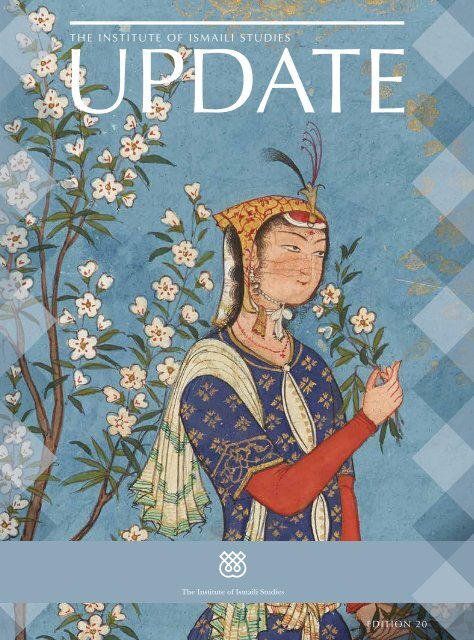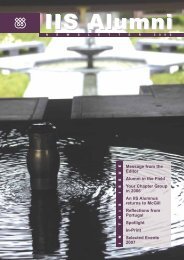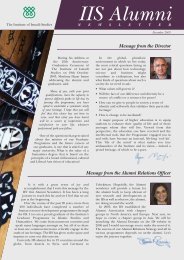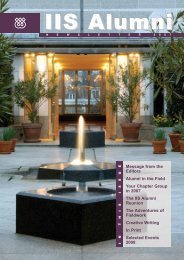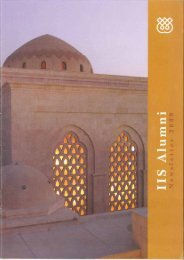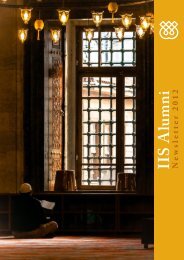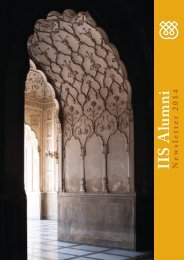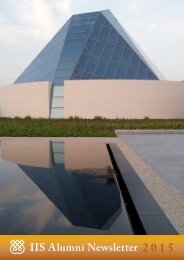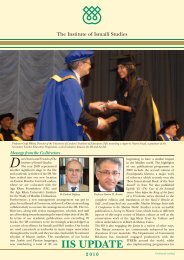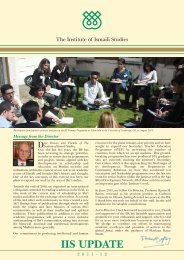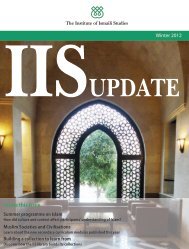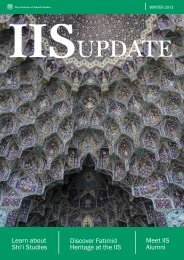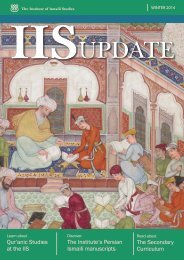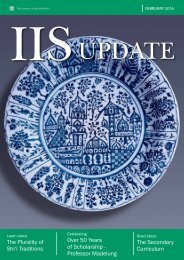IIS UPDATE Magazine Edition 20
Create successful ePaper yourself
Turn your PDF publications into a flip-book with our unique Google optimized e-Paper software.
THE INSTITUTE OF ISMAILI STUDIES<br />
<strong>UPDATE</strong><br />
EDITION <strong>20</strong>
CONTENTS<br />
4<br />
A Fresh Look at Women<br />
in Qur’anic Interpretation<br />
8<br />
Ismaili Festivals: Stories of<br />
Celebration<br />
12<br />
Explore Ismaili Heritage<br />
Material Online<br />
16<br />
Wladimir Ivanow and<br />
Modern Ismaili Studies<br />
18<br />
<strong>IIS</strong> Set to Launch Digital<br />
Curriculum Platform<br />
<strong>20</strong><br />
Student Voices: Exploring Identity<br />
Through Art and GPISH<br />
22<br />
Alumni: Highlights from Annual<br />
Profile Report <strong>20</strong><strong>20</strong><br />
24<br />
Three New Short Courses on<br />
Offer in <strong>20</strong>22<br />
25<br />
New Publications<br />
28<br />
In Memoriam: Janis Esots<br />
(1966–<strong>20</strong>21)<br />
Credits<br />
Published by: Department of Communications and Development, The Institute of Ismaili Studies.<br />
Designed by: Stephanie de Howes.<br />
Contributors: Naureen Ali, Dr Karen Bauer, Salima Bhatia, Kate Denereaz, Dr Feras Hamza, Russell Harris,<br />
Dr Shiraz Kabani, Lisa Morgan, Alnoor Nathani, Shameer Ali Prasla, Wendy Robinson, Rehana Virani, Nabila Walji.<br />
Front Cover: Detached album folio (cropped): Woman with a spray of flowers, Safavid period, c. 1575.<br />
Image credit: Arthur M. Sackler Gallery, Smithsonian Institution, Washington, D.C.: Purchase – Smithsonian<br />
Unrestricted Trust Funds, Smithsonian Collections Acquisition Program, and Dr. Arthur M. Sackler, S1986.296.<br />
2
THE INSTITUTE OF ISMAILI STUDIES<br />
Welcome<br />
I am pleased to be updating you, our valued<br />
supporters, once again on the Institute’s progress over<br />
the past year, and I hope you remain well and in good<br />
health. In <strong>20</strong>21 the <strong>IIS</strong> benefited from the gradual<br />
resumption of in-person working and collaboration,<br />
and launched several exciting digital projects that<br />
will extend the reach of its educational offerings.<br />
This year the <strong>IIS</strong> community has slowly begun to come<br />
together again in person. Our staff and researchers have<br />
been able to meet and collaborate once more in the<br />
inspiring environment of the Aga Khan Centre (AKC). It has<br />
been especially uplifting to see the return of our graduate<br />
students to face-to-face learning. We are proud to welcome<br />
students from countries in Asia, Africa, North America,<br />
Europe and Oceania this year. It is a pleasure to see the way<br />
in which these young people from Afghanistan to Kenya,<br />
New Zealand to Syria, have come together to create their<br />
own thriving student community. After the long periods of<br />
isolation of the previous year, I certainly am not alone in<br />
being delighted by the return to the convivial atmosphere<br />
of the AKC and the everyday life of the Institute.<br />
We are keen to draw upon the opportunities and lessons<br />
learnt from the recent pandemic. We continue to build on<br />
the integration of a digital approach in all aspects of our<br />
work. One of the most significant developments is set to be<br />
the launch of the <strong>IIS</strong> Digital Curriculum e-book platform.<br />
This adopts a multilingual approach, with e-books in ten<br />
languages, and will ensure that the <strong>IIS</strong> curriculum materials<br />
will be accessible to members of the global Jamat in even<br />
the remotest areas. This year we have also launched an<br />
online catalogue for our Ismaili Special Collections, allowing<br />
members of the community and researchers across the world<br />
to explore thousands of precious items of Ismaili heritage.<br />
Our research and publications work has continued apace,<br />
with the release of several new books and the launch of<br />
our first in-house series, Living Ismaili Traditions, created<br />
specifically for the Jamat. The first title in the series, Ismaili<br />
Festivals: Stories of Celebration, by Dr Shiraz Kabani, is a<br />
rich and personal exploration of different Ismaili traditions<br />
around the world. We have also recently published the<br />
second volume in our groundbreaking anthology of<br />
Qur’anic commentaries series that explores a critical<br />
theme: women in the Qur’an. An Anthology of Qur’anic<br />
Commentaries, Volume 2: On Women (Oxford University<br />
Press) represents a unique new resource for all scholars and<br />
students of the Qur’an and its interpretations, Islamic studies,<br />
and gender studies.<br />
We end the year with two particularly exciting events: an<br />
online conference on Fatimid Cosmopolitanism and an<br />
exhibition on Wladimir Ivanow, a pioneer of modern Ismaili<br />
studies, at the Aga Khan Centre Gallery. The conference invites<br />
world-renowned academics to share their research on a<br />
period central to the history of Shi‘i Ismailis. I will be speaking<br />
on Ivanow himself, whose life and work—which traces the<br />
contours of a transformative period in modern history—is the<br />
subject of our next exhibition at the AKC Gallery. I hope you<br />
will be able to visit it if you are in London.<br />
I would also like to take a moment to remember our<br />
colleague and esteemed scholar, Dr Janis Esots, who sadly<br />
passed away in <strong>20</strong>21. Janis joined the <strong>IIS</strong> in <strong>20</strong>13 as a<br />
Research Associate in the Shi‘i Studies Unit and, aside<br />
from his native Latvian, he was a master of the English,<br />
Russian, Arabic and Persian languages. During his lifetime<br />
he published a significant number of scholarly editions,<br />
translations and commentaries of Islamic philosophical and<br />
esoteric texts. We will miss him as a friend, colleague and<br />
rare scholar.<br />
Finally, I would like to thank you for your continued support<br />
and interest in the work of the Institute. Promoting a better<br />
understanding of Islam continues to be our core endeavour<br />
and I look forward to updating you on the ways we continue<br />
to work towards this goal, with your support, in <strong>20</strong>22.<br />
Farhad Daftary,<br />
Co-Director, <strong>IIS</strong><br />
3
A Fresh Look at<br />
Women in Qur’anic<br />
Interpretation<br />
Building on the success of An Anthology of Qur’anic Commentaries, Vol. I: On<br />
the Nature of the Divine, the second volume in the series focuses on a critical and<br />
contentious theme: Women in the Qur’an and traditional Qur’anic commentaries.<br />
An Anthology of Qur’anic Commentaries, Vol. II: On Women comprises analyses of<br />
the female subject in the Qur’an, annotated translations of Qur’anic commentaries<br />
spanning twelve centuries, interviews with contemporary Muslim scholars and<br />
extensive introductory materials, which frame the work throughout and render<br />
these technically complex materials accessible to the reader.<br />
Dr Feras Hamza and Dr Karen Bauer, the editors of On Women. Image credit: <strong>IIS</strong><br />
4
THE INSTITUTE OF ISMAILI STUDIES<br />
We sat down with the book’s editors, Dr Karen Bauer and<br />
Dr Feras Hamza, to find out how the tradition of Qur’anic<br />
commentary views women in the Qur’an, how it continues<br />
to influence many Muslim women’s lives today, and why it<br />
was so important to feature contemporary women’s voices.<br />
What were your motivations in choosing the theme<br />
of women for the latest anthology?<br />
Karen Bauer My academic specialty is in women and<br />
gender in Islam, so it came about very organically. But<br />
I think it’s worked well in a lot of ways, especially given<br />
the social impact of some of the issues that have to do<br />
with women.<br />
Feras Hamza The Anthology of Qur’anic Commentaries<br />
series has several other themes always in play, so one way<br />
of rephrasing your question is, why was this topic pushed<br />
up in the sequence? I think there’s an immediate social<br />
urgency to it.<br />
What can readers expect from the book?<br />
Karen Bauer The textual tradition dedicated to interpretation<br />
of the Qur’an (tafsir) is very male centred and scholastic.<br />
We’ve provided introductions to make it more accessible<br />
to the reader. We’ve also provided a counterfoil to it, by<br />
including some modern voices—interviews with reformists<br />
and women themselves. So a reader can expect to become<br />
acquainted with this tradition that’s had an effect on many<br />
people’s lives, and which, in some cases, has shaped laws in<br />
Muslim-majority parts of the world. And then we introduce<br />
the idea that there are alternatives to that and there probably<br />
always were, but those alternative voices are missing from<br />
what we read of the medieval scholastic tradition.<br />
Why did you choose the verses you used in the book?<br />
Karen Bauer Three of the verses were chosen because they<br />
represent pressing social concerns for Muslim women today.<br />
The first relates to spousal roles and this very vexed question<br />
of the rights of the husband over the wife. The second is<br />
on women’s testimony. Again, it’s something that actually<br />
still affects women in some Muslim-majority countries<br />
today, and in sharia courts. The third is on the veil, and<br />
that, of course, is also of great interest to Muslim women<br />
themselves. The other verses are about women’s spiritual<br />
equality and creational equality with men.<br />
Feras Hamza There’s a sense of responsibility, as editors,<br />
that we don’t just present the medieval tradition, because<br />
we know that they’re restricted in their worldview. So<br />
we wanted to give some indication of how the subject of<br />
‘women’ could be read otherwise through the text of the<br />
Qur’an, and sometimes even through the medieval tradition<br />
itself, by including other instances.<br />
Karen Bauer Take a verse like Qur’an 4:1, which talks<br />
about God creating humans from a single soul. This is a<br />
verse that for a lot of modern readers indicates creational<br />
equality between men and women. What’s so fascinating<br />
is that the medieval commentators will say that the verse<br />
proves the creation of Eve from Adam and that women are a<br />
secondary creation. It’s one of those moments where, within<br />
the Qur’an, one thing is being put forth, and within that<br />
commentarial tradition, cultural assumptions are being put<br />
forth. And those cultural assumptions have had a very heavy<br />
weight for women who’ve had to live with them.<br />
How did commentators interpret these verses<br />
over the years?<br />
Feras Hamza Well, as their predecessors did. The medieval<br />
Muslim commentarial tradition has a kind of stability of<br />
opinion that you can probably trace into the <strong>20</strong>th century.<br />
It’s only really with the <strong>20</strong>th century that you begin to see a<br />
slight rupture, in the sense of other voices emerging.<br />
Karen Bauer And because women’s own voices are absent,<br />
and because any alternative perspectives are absent, you get<br />
a certain rigid way of reproducing the power and authority<br />
that’s vested in those scholars. It’s precisely their dismissal of<br />
women’s rational ability that continues to marginalise women<br />
from that tradition. Because, essentially, you’re looking at<br />
a tradition where the scholars had absolutely no incentive<br />
to let anyone else in. That’s how power and authority end<br />
up working, and it calls into question how much authority<br />
should be vested in that medieval tradition today.<br />
The textual tradition dedicated to<br />
interpretation of the Qur’an (tafsir) is<br />
very male centred and scholastic. We’ve<br />
provided introductions to make it more<br />
accessible to the reader. We’ve also<br />
provided a counterfoil to it, by including<br />
some modern voices—interviews with<br />
reformists and women themselves. So a<br />
reader can expect to become acquainted<br />
with this tradition that’s had an effect<br />
on many people’s lives, and which, in<br />
some cases, has shaped laws in Muslimmajority<br />
parts of the world.<br />
Karen Bauer<br />
5
A FRESH LOOK AT WOMEN IN QUR’ANIC INTERPRETATION<br />
When we started to write<br />
about women in the Qur’an itself,<br />
to provide a bit of counterbalance<br />
to what’s going on in the tradition,<br />
we were very surprised by what<br />
we found. I was surprised by how<br />
intrinsic women are in the whole<br />
Qur’anic narration and how the<br />
discourse on women in the Qur’an<br />
changes through time.<br />
Karen Bauer<br />
Feras Hamza There are many modernists who would say<br />
that you can throw out that medieval tradition, but there’s<br />
no denying that it continues to exert a huge amount<br />
of influence where people really do believe that this<br />
authoritative tradition represents what God wants from them.<br />
Karen Bauer We were teaching the other day and one<br />
of the students said that in her home country, a woman<br />
couldn’t testify to her own rape because she needed four<br />
male witnesses to that. Laws like that are directly related to<br />
the medieval interpretations that we have now translated,<br />
and that is one of the reasons why it’s so important to point<br />
out how that tradition was shaped, who was writing that<br />
tradition and how power and authority create interpretations<br />
that further marginalise the marginalised: in this case,<br />
women themselves. We had to say to that student, well, that<br />
is not from the Qur’an, that is from the medieval tradition.<br />
What new insights do you hope to bring with<br />
the book?<br />
Feras Hamza There would have been a potential intellectual<br />
delinquency if we had left this subject in the hands of the<br />
commentators alone. We were really surprised in a positive<br />
way that a lot of that dismissive attitude towards the<br />
subject of women is not actually merited at all by the<br />
Qur’anic narrative.<br />
How does the book help us to understand<br />
contemporary issues for women in Islam?<br />
Feras Hamza This is not just an armchair issue that one<br />
can just discuss without any real-world repercussions.<br />
We’re talking about situations of real violence that women<br />
can find themselves in. I think that’s the thing we were<br />
most conscious of: the responsibility of what happens<br />
when an anthology is sealed in writing and has a stamp of<br />
Oxford University Press and a prestigious institute. If that’s<br />
unqualified, it’s almost like saying, that’s how it is and that’s<br />
how it’s always going to be and that’s fine. There’s a sense of<br />
urgency to rethink, because if you just look at the Qur’anic<br />
narrative, it actually offers a lot more than what the medieval<br />
tradition says. This is the context in which we can then begin<br />
to look at issues to do with contemporary life for Muslim<br />
women across the world.<br />
An Anthology of Qur’anic Commentaries, Volume 2: On<br />
Women is published by Oxford University Press (<strong>20</strong>21).<br />
There’s a sense of urgency to<br />
rethink, because if you just look at<br />
the Qur’anic narrative, it actually<br />
offers a lot more than what the<br />
medieval tradition says.<br />
Feras Hamza<br />
Karen Bauer The chapter on women in the Qur’an has the<br />
potential to offer new insights into the way that women were<br />
a part of the initial Qur’anic community. When we started to<br />
write about women in the Qur’an itself, to provide a bit of<br />
counterbalance to what’s going on in the tradition, we were<br />
very surprised by what we found. I was surprised by how<br />
intrinsic women are in the whole Qur’anic narration and<br />
how the discourse on women in the Qur’an changes through<br />
time, and that’s what we document in that chapter.<br />
6
THE INSTITUTE OF ISMAILI STUDIES<br />
Qur’an manuscript Surat al-Nisa (Chapter of the women), showing part of verse 4:1. The fragment appears to date from the Ilkhanid period (c. 1250–1350) and<br />
may have been produced in the imperial centre of Tabriz in north-western Iran. Image credit: Unknown author, Public domain, via Wikimedia Commons.<br />
7
Ismaili Festivals:<br />
Stories of Celebration<br />
Members of the Ismaili Jamat (community) in Bartang Valley, Tajikistan, waiting for the didar of Mawlana Hazar Imam, 25 September 1998. Image credit: AKDN/Zahur Ramji.<br />
8
THE INSTITUTE OF ISMAILI STUDIES<br />
Ismaili Festivals: Stories of Celebration by Dr Shiraz Kabani is the<br />
first title in the <strong>IIS</strong>’s new Living Ismaili Traditions series. The book is a<br />
unique and personal account of festivals and traditions from the author’s<br />
own lived experience as an Ismaili. Here Dr Kabani—who heads the<br />
<strong>IIS</strong>’s Department of Community Relations—reflects on the aims of the<br />
series, who it is for, and the importance of storytelling.<br />
Returning to the festivities at London Olympia, the round of<br />
rasda was followed by dandiya raas, which is often part of<br />
the Imamat Day and other celebrations among South Asian<br />
Ismailis. This traditional folk dance is performed with one or<br />
two dandiyas, which are foot-long wooden sticks. Although it<br />
has many forms, it generally involves two individuals striking<br />
their sticks in a rhythm, while stamping their feet on the<br />
ground, like in a sword fight. Some believe it is a symbolic<br />
re-enactment of a sword fight between the forces of good and<br />
evil. After two strikes, the partners swirl to exchange sides<br />
and repeat the motion. The striking of sticks and stamping<br />
of feet correspond to the beat of instrumental music. When<br />
many couples perform this dance together, the swirling and<br />
circular movements are quite mesmerising. I have rarely<br />
played dandiya raas myself, but watching it enhances my<br />
joy in celebrating the blessing of Imamat in my life.<br />
From Ismaili Festivals: Stories of Celebration, Chapter 9: Imamat Day<br />
and the Spiritual Leadership of Mawlana Hazar Imam, pp.169–170<br />
9
ISMAILI FESTIVALS: STORIES OF CELEBRATION<br />
Please could you tell us about the genesis of the<br />
Living Ismaili Traditions series?<br />
For a number of years the Institute has been working on<br />
developing publications that will appeal to individuals who<br />
are not academics in the field of Islamic studies, where we<br />
could bring together a lot of the research and scholarship<br />
that has been undertaken by the Institute. The Living<br />
Ismaili Traditions series was conceptualised specifically<br />
for the Ismaili community to address some of the issues<br />
of contemporary relevance to the community. And given<br />
that most communities are made up of people who have<br />
shared narratives, shared stories, shared festivals, we<br />
thought that the first book could take this up as a subject to<br />
communicate certain important ideas to the community.<br />
There is much in Ismaili history, particularly in terms of the<br />
recent past—stories of migration, stories of settlement, how<br />
communities in different parts of the world have developed—<br />
that has not been talked or written about, at least not in very<br />
accessible language. Unless they are scholars in the field<br />
of Ismaili studies, many in the community are not familiar<br />
with parts of the history of the community, except what is<br />
commonly known. And so it is our hope that these books will<br />
shed light on important episodes and personalities in Ismaili<br />
history, so that the Jamat is better aware and understands its<br />
own past and present better.<br />
Families break their fast in front of the Hagia Sophia, Istanbul, during Ramadan.<br />
Image credit: Ton Koene / Alamy Stock Photo; ID CY33E0.<br />
Can you tell us about the role of storytelling in<br />
Ismaili Festivals: Stories of Celebration?<br />
Anthropologists tell us that human societies have told stories<br />
to each other since time immemorial. I remember reading<br />
a research study where students in a classroom were shown<br />
certain geometrical figures as part of a film, and they were<br />
asked to make sense of it. Every single person, except for<br />
one individual, made a story out of those patterns. What that<br />
tells us is that we tell stories to make sense of things. We are<br />
meaning-makers by nature, and we need to tell stories to<br />
ourselves, to see patterns, because that helps to make sense<br />
of the world around us.<br />
In the book you will find three different types of stories.<br />
First, stories that are closely associated with the festivals<br />
have been included. So, for example, the story of Prophet<br />
Abraham and his son, and their sacrifice, is associated<br />
I’m hopeful that when<br />
people read this book, they will<br />
be encouraged and motivated<br />
to read more of the stories, but<br />
also to tell more stories among<br />
themselves.<br />
10
THE INSTITUTE OF ISMAILI STUDIES<br />
An outdoor Nawruz celebration, with food and newly grown sprouts in Hisor,<br />
Tajikistan. Image credit: ITAR-TASS News Agency / Alamy Stock Photo; ID M8X8B6.<br />
with Eid al-Adha and is therefore narrated. The second type<br />
of stories are those that have come down to us in history,<br />
mostly through oral tradition. These are stories that you<br />
find in the Hadith, stories that you find in the Mathnawi of<br />
Rumi, for example. These were selected on the basis of their<br />
contemporary relevance. The third are stories from my own<br />
life, some funny, some sombre, but events that taught me<br />
lessons that may be of relevance to the readers of the book.<br />
The first idea that I’ve tried<br />
to communicate in the book is<br />
about diversity and its beauty,<br />
for people to understand the<br />
astonishing diversity that exists in<br />
human societies, more specifically<br />
in the Muslim world, and also<br />
amongst Ismaili communities.<br />
Can you give us a taste of one of the festival<br />
experiences you write about in the book?<br />
In the chapter on Imamat Day, which is the celebration of the<br />
anniversary of the present Imam’s accession to the Imamat,<br />
I describe celebrations in London. Beyond the gatherings in<br />
Jamatkhanas, on this occasion there are usually exuberant<br />
celebrations where a large number of Ismailis get together in a<br />
spirit of joy and camaraderie. During those celebrations, there<br />
are certain songs that are sung and dances that are performed<br />
in large groups. In the book, I have tried to describe that<br />
scene and then explore the purpose and meaning of the<br />
celebrations. In this context, I have also discussed how such<br />
celebrations are frowned upon in some Muslim interpretations<br />
and why this is not perceived as an issue amongst the Ismailis.<br />
What are some of the ideas you explore in the book?<br />
The first idea that I’ve tried to communicate in the book is<br />
about diversity and its beauty, for people to understand the<br />
astonishing diversity that exists in human societies, more<br />
specifically in the Muslim world, and also amongst Ismaili<br />
communities. The second, related idea is that, within this<br />
diversity, there is also a unity. There is much among the<br />
Ismailis in terms of their culture, their festivals, and their<br />
stories that they share with other traditions of Muslims,<br />
and indeed, with other religious communities. And the third<br />
idea is to reinvigorate this notion of storytelling, which is an<br />
art that, in my view, we seem to be losing. And I’m hopeful<br />
that when people read this book, they will be encouraged<br />
and motivated to read more of the stories, but also to tell<br />
more stories among themselves.<br />
Who is the book for?<br />
If you are someone who wants to know something more<br />
about the Ismaili tradition, its cultures, its stories, its festivals,<br />
then this book is for you. If you are faced with questions<br />
about your tradition and are looking for ways to respond,<br />
then this book is for you. I’ve specifically written it for people<br />
who don’t have academic expertise in the field of Islamic<br />
studies. Wherever there is a complicated idea, I’ve provided<br />
contemporary examples for readers to understand those ideas.<br />
So, if you feel that you want to better understand your own<br />
Ismaili tradition, then this book is for you.<br />
Ismaili Festivals is available to order from local ITREBs.<br />
11
Explore Ismaili Heritage<br />
Material Online<br />
A manuscript of Urdu commentary on Mathnawi of Rumi, nineteenth century. Image credit: <strong>IIS</strong>.<br />
The launch of an online catalogue of special collections housed at the <strong>IIS</strong> enables<br />
exploration of many precious examples of Ismaili heritage material. Naureen<br />
Ali, who looks after the collections management system (Adlib) and the online<br />
catalogue for the Ismaili Special Collections Unit (ISCU), presents highlights now<br />
accessible via the new online collection.<br />
This online catalogue<br />
represents a key milestone<br />
in making accessible the rich<br />
heritage of Ismaili communities<br />
from around the world to a<br />
varied audience including<br />
researchers, students and<br />
interested members of the<br />
public. It is hoped that the<br />
catalogue will be an important<br />
tool in facilitating research<br />
and educational activities<br />
on various aspects of the<br />
intellectual and literary heritage<br />
of the Ismaili communities.<br />
Dr Wafi Momin,<br />
Head of the Ismaili Special Collections Unit<br />
The Ismaili Special Collections Unit (ISCU) has launched<br />
an online catalogue of special collections housed at<br />
the <strong>IIS</strong>. Featuring information on thousands of items,<br />
the catalogue will enable a wide range of audiences,<br />
including researchers, to explore heritage relating to<br />
Ismaili communities online.<br />
The <strong>IIS</strong> holds a significant repository of special<br />
collections related to the heritage of Ismaili communities<br />
and other Muslim traditions. These collections include<br />
nearly 3,000 manuscripts in Arabic, Persian, Indic and<br />
other languages, as well as coins, glass weights, medals<br />
and other historical artefacts, photographs and audiovisual<br />
materials, rare and special printed materials<br />
(including periodicals) and archival collections.<br />
In <strong>20</strong>13 the <strong>IIS</strong> established ISCU as part of its continuing<br />
endeavours to systematically preserve, develop, digitise<br />
and catalogue these collections; ISCU was also founded<br />
to study and facilitate research on these materials,<br />
in order to contribute to the <strong>IIS</strong>’s vision of promoting<br />
scholarship on the heritage of Ismaili communities and<br />
that of other Muslim groups. These special collections<br />
have been at the heart of the research, publications and<br />
educational programmes undertaken by the <strong>IIS</strong> over<br />
the years.<br />
12
THE INSTITUTE OF ISMAILI STUDIES<br />
The following are some of the unique items now catalogued and available for<br />
researchers to learn more about as part of the <strong>IIS</strong> online special collection.<br />
Kitab al-manazāẓir (Opticae Thesaurus) by<br />
Abu ‘Ali al-Hasan ibn al-Haytham<br />
Known as Alhazen in Europe, Abu ‘Ali al-Hasan ibn<br />
al-Haytham was born in Basra in the tenth century and<br />
later moved to Cairo. Owing to his work on human visual<br />
perception, he is considered the father of modern optics.<br />
In <strong>20</strong>15 UNESCO celebrated the International Year of<br />
Light by marking the 1,000-year anniversary of his most<br />
famous work, Kitab al-manazir (Book of Optics), which<br />
was translated into Latin in the thirteenth century and<br />
influenced European thinkers and scientists.<br />
Fatimid Cairo in al-Haytham’s lifetime was home to a<br />
dedicated institution of higher learning known as the<br />
Dar-al-Hikma (House of Wisdom). Built in 395 AH/1005<br />
AD by the Fatimid Imam-Caliph Abu ‘Ali al-Mansur al-<br />
Hakim bi-Amr Allah (386–411 AH/996–1021 AD), the<br />
institution served those who specialised in non-religious<br />
sciences. Being a polymath, al-Haytham not only worked<br />
on the principles of optics but also produced works on<br />
mathematics and astronomy.<br />
A Latin translation of Kitab al-manazir (Opticae Thesaurus), by Abu ‘Ali al-Hasan<br />
ibn al-Haytham, published in Basileae in 1572 AD. Image credit: <strong>IIS</strong>.<br />
A set of two rock crystal<br />
three-faced seals and two<br />
metal seals from Aga Khan I<br />
(c. 1258–1283 AH/1842–1866 AD).<br />
Image credit: <strong>IIS</strong>.<br />
Seals from Aga Khan I<br />
The inscription on the rock crystal seals includes a line from the invocation, Nada ‘Ali, which is a prayer used by Shi‘i<br />
Muslims, along with some Qur’anic verses. The inscriptions on the metal include the name Muhammad Hasan al-Husayni,<br />
also known as Hasan ‘Ali Shah (Aga Khan I).<br />
Hasan ‘Ali Shah was born in Kahak in 1804 AD and arrived in Gujarat, India in 1845 AD. According to Dr Farhad Daftary,<br />
in his book The Ismaili Imams: A Biographical History, he was the first Imam of his time to set foot in India and his<br />
permanent settlement in Bombay in 1848 marked the beginning of the modern period in the history of the Ismailis.<br />
A manuscript of his autobiography entitled ‘Ibrat-afza about his life in Iran and India is part of the <strong>IIS</strong> special collections<br />
and was critically edited and translated into English by the <strong>IIS</strong> in <strong>20</strong>18.<br />
13
EXPLORE ISMAILI HERITAGE MATERIAL ONLINE<br />
A dinar of Fatimid Imam-Caliph al-‘Aziz<br />
The special collections housed at the <strong>IIS</strong> include coins from<br />
the Fatimid and Alamut periods. Featuring a variety of mints,<br />
types, years of production and associated rulers, these coins<br />
help enhance our understanding of historical events.<br />
The featured dinar from Fatimid Imam-Caliph Nizar Abu<br />
al-Mansur al-‘Aziz billah was minted in Palestine in 382 AH/<br />
992 AD. An excellent administrator, Fatimid Imam-Caliph<br />
al-‘Aziz sought to expand the Fatimid empire during his rule.<br />
According to Dr Farhad Daftary, in his book The Ismaili Imams:<br />
A Biographical History, “By the end of his reign, the Fatimid<br />
empire had attained its greatest geographical extent, with<br />
Fatimid sovereignty recognised from the Atlantic and western<br />
Mediterranean to the Red Sea, the Hijaz, Syria and Palestine.”<br />
Coins from the Fatimid era reflect the expanse of the Fatimid<br />
state and the regions they ruled. The quality of the coins is<br />
also indicative of the strength and power of the Fatimids.<br />
Fatimid coins were particularly valuable in terms of their<br />
gold content and were renowned across Mediterranean<br />
lands, as well as along international trade routes.<br />
A dinar of Fatimid Imam-Caliph Nizar Abu al-Mansur al-‘Aziz billah<br />
(r. 365–386 AH/975–996 AD). Image credit: <strong>IIS</strong>.<br />
Photograph of Aga Khan III<br />
Photographs (in digital and print format) form a<br />
significant part of the special collections at the <strong>IIS</strong>.<br />
As a repository of the heritage of Ismaili communities,<br />
the special collections housed at the <strong>IIS</strong> include<br />
memorabilia relating to the 48th Imam of the<br />
Nizari Ismailis, Aga Khan III, and the present Imam,<br />
Aga Khan IV, such as printed material, commemorative<br />
coins, badges and medals relating to their various<br />
Jubilee celebrations.<br />
A photograph of Aga Khan III, dated 1919. Image credit: <strong>IIS</strong>.<br />
14
THE INSTITUTE OF ISMAILI STUDIES<br />
Photo of Women Playing Daf from ‘Pamir’ Album<br />
This photograph is from a 1930s photo album that includes photographs<br />
of the Shughnan and Rushan regions of Soviet Tajikistan. Containing<br />
around 100 photographs, the album highlights the social and cultural<br />
life of the peoples of Gorno-Badakhshan, including images of children,<br />
musicians, local famous dancers and religious dignitaries. Photographs<br />
of the remains of the Vamar castle, which used to be the residence of the<br />
local rulers, are also included, along with the castle of Bar-Panja,<br />
the residence of the local rulers of Shughnan.<br />
The ISCU online catalogue will launch in December.<br />
Please visit www.iis.ac.uk/special-collections for access.<br />
A group of women playing the drum (daf) (from the photo album, ‘Pamir’, c.1930s). Image credit: <strong>IIS</strong>.<br />
15
HEADING HERE<br />
Wladimir Ivanow<br />
and Modern Ismaili Studies<br />
A new exhibition at the Aga Khan Centre<br />
Gallery introduces the life and work of<br />
the Russian scholar Wladimir Ivanow<br />
(1886–1970) and explores his<br />
vital role in the formation of<br />
modern Ismaili studies.<br />
16<br />
16<br />
Wladimir Ivanow, photograph taken c. 1907 in Tsarskoe Selo by the photographer M.A. Kahn. Image credit: Institute of Oriental Manuscripts, Russian Academy of Sciences, St Petersburg.<br />
A view of Alamut, the most famous fortress of the Nizari Ismaili state in Iran. Image credit: Alamut Cultural Base.
THE INSTITUTE OF ISMAILI STUDIES<br />
The exhibition traces the contours of a transformative period<br />
in modern history, from the October 1917 Revolution in<br />
Russia to the height of the Imperial Russian and British<br />
empires and their dissolution into the new nations of Central<br />
Asia and the Indian subcontinent. This radical territorial<br />
rearrangement had long-lasting ramifications across the<br />
Muslim world, which over the span of just a few decades<br />
saw both the abolition of the Ottoman Caliphate in 1924 and<br />
the establishment of the twentieth century’s first avowedly<br />
Muslim nation state, Pakistan, in 1947. This is paralleled by<br />
a significant shift in the academic study of Islam, with an<br />
increasing interest in Shi‘ism, and Ismaili Shi‘ism in particular.<br />
Following Ivanow across the world—from his early travels<br />
in Iran to his arrival and sojourn in colonial Bombay—the<br />
exhibition positions the scholar and his research at the very<br />
heart of this transformative epoch. The exhibition illustrates<br />
the historical context of the period but also sheds light on<br />
how Ivanow’s life was directed by his chosen field of study:<br />
Ismaili history and thought. Visitors will be introduced to<br />
the history of Ismaili studies and aspects of the history of<br />
Ismailism itself, while also discovering the crucial role Ivanow<br />
played in the formation and consolidation of the emerging<br />
discipline of Ismaili studies, most particularly with reference<br />
to his recovery of manuscripts long kept hidden by the various<br />
Ismaili communities with whom he came into contact.<br />
“Ivanow’s excitement must have been palpable as he examined<br />
the contents of manuscripts that had lain unstudied for centuries,<br />
and perhaps this was what provided the adrenalin for him to<br />
produce his prolific academic output,” says Russell Harris, an<br />
editor at the <strong>IIS</strong> who has assisted with the exhibition. Mr Harris<br />
also worked with Dr Farhad Daftary, Co-Director of the Institute,<br />
on Fifty Years in the East, Ivanow’s memoirs, and finds Ivanow’s<br />
academic rigour, dedication and sense of adventure impressive<br />
and inspiring. Dr Daftary also commented that “it is about<br />
time for us to properly recognise the contributions of<br />
Wladimir Ivanow as the foremost pioneer of Ismaili studies.”<br />
The exhibition also features photographs of academic<br />
personalities who either influenced or collaborated with<br />
Ivanow, as well as showcasing a selection of relevant printed<br />
works, manuscripts and correspondence. Ivanow’s journeys<br />
and the body of work he produced during his lifetime are<br />
illustrated with a timeline and map. According to Dr Taushif<br />
Kara, the exhibition’s co-curator, “The formation of modern<br />
Ismaili studies was intimately linked to the life and work of<br />
Wladimir Ivanow. But what I did not realise prior to working on<br />
this exhibition was just how crucial he was in the development<br />
of Islamic studies as well. Many of the individuals who came<br />
to dominate the academic study of Islam in the twentieth<br />
century—from Bernard Lewis to Marshall Hodgson—began<br />
their scholarly careers studying Ismaili history, and so were<br />
indebted to Ivanow’s pioneering research in different ways.<br />
“Helping to curate this exhibition pushed me to reflect on the<br />
significant connections between the study of Ismaili history<br />
and the wider study of Islam in the twentieth century. We hope<br />
to discuss these fascinating but often unexplored connections<br />
further at a forthcoming workshop on the topic at the Aga Khan<br />
Centre in <strong>20</strong>22, held in collaboration with the Centre of Islamic<br />
Studies, Cambridge, and The Institute of Ismaili Studies.”<br />
The exhibition is accompanied by a short documentary film<br />
featuring interviews with historians and academics, including<br />
Dr Farhad Daftary, who himself has been greatly influenced by<br />
Ivanow and has continued to build on his legacy and work.<br />
In many ways, the endeavours of Ivanow prefigured the<br />
scholarly work of The Institute of Ismaili Studies more<br />
broadly, and his prolific output to a great extent mirrors the<br />
current areas of research at the Institute, particularly the<br />
disciplines of Central Asian, South Asian and Shi‘i studies.<br />
In many ways, the endeavours<br />
of Ivanow prefigured the scholarly<br />
work of The Institute of Ismaili<br />
Studies more broadly, and his<br />
prolific output to a great extent<br />
mirrors the current areas of research<br />
at the Institute, particularly the<br />
disciplines of Central Asian, South<br />
Asian and Shi‘i studies.<br />
“Wladimir Ivanow and Modern Ismaili Studies” is the second<br />
exhibition that the <strong>IIS</strong> has organised in honour of Ivanow.<br />
Dr Hakim Elnazarov, Head of the Central Asian Studies Unit at<br />
the <strong>IIS</strong>, who initiated the first Ivanow exhibition, in St Petersburg,<br />
Russia, in October <strong>20</strong>19, says “Ivanow was a Russian orientalist,<br />
whose ground-breaking research in Ismaili studies has not yet<br />
been fully appreciated. The first exhibition, in St Petersburg,<br />
highlighted the contribution of Ivanow and Russian scholarship<br />
to Ismaili studies. The London exhibition builds on this vision<br />
and showcases the origins of modern Ismaili studies, which was<br />
driven by Ivanow. The exhibition provides a visual illustration of<br />
the journey Ismaili studies made in the last century, and it strives<br />
to inspire a new generation of students and scholars to advance<br />
Ismaili studies in the modern age.”<br />
Wladimir Ivanow and Modern Ismaili Studies will run at the<br />
Aga Khan Centre Gallery, London, until 31 March <strong>20</strong>22.<br />
For further information on the exhibition and associated<br />
learning programme please visit www.agakhancentre.org.<br />
uk/gallery/wladimir-ivanow-and-modern-ismaili-studies.<br />
17
<strong>IIS</strong> Set to Launch Digital<br />
Curriculum Platform<br />
We are excited to announce that, as part of its long-term digital strategy,<br />
the <strong>IIS</strong>’s Department of Curriculum Studies is soon to start a phased<br />
roll-out of the <strong>IIS</strong> Digital Curriculum (<strong>IIS</strong>DC) e-book platform.<br />
The <strong>IIS</strong> Digital Curriculum opens up exciting possibilities for the creative<br />
use of the curriculum materials. In the coming years, we look forward to<br />
increasing the technical sophistication of the digital platform to make the<br />
educational process even more engaging and fulfilling for students, teachers,<br />
parents and other members of the Ismaili community.<br />
Alnoor Nathani, Design and Production Manager | Shameer-Ali Prasla, Digital Education Officer<br />
The <strong>IIS</strong>DC aims to make the curriculum materials published<br />
by the <strong>IIS</strong> available as e-books to pre-school, Ta‘lim and<br />
Secondary Teacher Education Programme (STEP) teachers,<br />
and to students, parents and members of the Ismaili<br />
community in general. The e-book platform is intended to<br />
facilitate teaching under the current pandemic and also,<br />
crucially, to widen access to the curriculum in remote areas.<br />
The curriculum developed by the <strong>IIS</strong> presents a graded<br />
programme of instruction which examines Islam as both<br />
faith and civilisation, historically and today. Its overall aim<br />
is to educate young Ismailis in the faith, ethics, history<br />
and cultures of Muslim societies, and the Ismaili Muslim<br />
community in particular.<br />
The curriculum draws on modern principles of education,<br />
with the intention of making learning a creative and<br />
engaging experience for young minds, as well as seeking<br />
to bridge religious and secular education. The teaching and<br />
learning materials include student readers and textbooks,<br />
guides for teachers and parents, and learning resources such<br />
as activity books, posters and picture cards.<br />
The new digital curriculum platform adopts a multilingual<br />
approach, aiming to make the e-books available in ten<br />
languages on a phased basis. The user interface in English,<br />
French, Portuguese and Gujarati has been completed, with<br />
the interface in another six languages under development.<br />
The <strong>IIS</strong>DC platform benefits from multiple navigation features,<br />
annotation tools, and search facilities within and across<br />
e-books. It will also offer downloadable offline apps for<br />
Windows and Mac OS operating systems. Apps for Android<br />
and iOS, currently under development, will allow the e-books<br />
to be downloaded onto the user’s personal devices for offline<br />
reading. A custom registration app has also been developed to<br />
assist ITREBs to create and manage user accounts.<br />
The <strong>IIS</strong>DC has been pilot tested with the help of STEP and<br />
Ta‘lim teachers in different regions. Their comments and<br />
suggestions have been instrumental in refining the e-book<br />
platform. The DCS would like to thank all the ITREBs, STEP and<br />
Ta‘lim teachers, and TKN volunteers for their assistance and<br />
support in bringing this vital new educational tool to the Jamat.<br />
Further details on accessing the e-book platform can be<br />
obtained from ITREBs.<br />
18
THE INSTITUTE OF ISMAILI STUDIES<br />
Hear about teachers’ experience:<br />
I think the <strong>IIS</strong>DC<br />
e-book platform is such an<br />
amazing initiative [which<br />
aims] to have essential<br />
curriculum books on one<br />
platform. They are easy to<br />
access and use—facilitating<br />
not only the teaching and<br />
learning process but also<br />
[for] easy reference<br />
whenever one needs.<br />
Participant, ITREB Pakistan<br />
Overall, it is very<br />
accessible and effective<br />
in design. I liked the way<br />
it has eased [how] one<br />
navigates through pages<br />
of the books through<br />
search, notes, highlight<br />
options.<br />
Participant, ITREB Canada<br />
I think the e-book<br />
platform is very useful<br />
for teachers and<br />
teacher educators,<br />
not only in teaching<br />
but in making lesson<br />
plans, and as a<br />
resource and tool to<br />
make teaching and<br />
learning meaningful<br />
and productive.<br />
Participant, ITREB D.R.Congo<br />
A page from the new <strong>IIS</strong> digital curriculum. Image credit: <strong>IIS</strong>.<br />
19<br />
19
Student Voices:<br />
Exploring Identity Through<br />
Art and GPISH<br />
Nabila on Kenyatta Avenue in Nairobi, Kenya. Image credit: Nabila Walji.<br />
Nabila Walji is a third-year student on<br />
the Graduate Programme in Islamic<br />
Studies and Humanities (GPISH) and<br />
in <strong>20</strong>21 opened her first exhibition—<br />
UnBelonging in my Fatherland—with<br />
Calgary’s Arts Commons. Here she talks<br />
about her combined academic-artistic<br />
photographic and writing practice,<br />
which explores identity, culture,<br />
discrimination and community, with a<br />
focus on her partly East African heritage.<br />
Please could you tell us a bit about your exhibition<br />
UnBelonging in my Fatherland and the subject<br />
matter it covers?<br />
The exhibition is about evoking that sense that I think<br />
everyone feels to differing degrees, of not belonging in a<br />
place that they're from, or that they live in—and about that<br />
universal search for a home. But on a more specific level,<br />
it's about my own journey of being a Canadian, who always<br />
grew up thinking that they're part South Asian and part East<br />
African, but in going to my East African fatherland finding that<br />
un-belonging could be found in the place that I thought was<br />
my homeland as well. I think, for any diasporic or migratory<br />
peoples, including Ismailis, there's a huge resonance, in terms<br />
of the story that the exhibition is telling, because many of us<br />
have been migratory or have had to move.<br />
What prompted you to start the project or start<br />
asking those questions?<br />
It comes partly from my youth, of being a person of colour<br />
in a Canadian society, where many people are told—<br />
whether they're born there, they're first, second, third or<br />
fourth generation—they're still told: go back to where you<br />
came from. And so I guess for me, subtly or not so subtly,<br />
it made me ask: where is that place? And I found that it<br />
is kind of elusive, that there's no actual origin point. The<br />
next layer then comes from my own experiences living and<br />
working in East Africa and reflecting on my positionality in<br />
that society when I was there. And the complexity of being<br />
what they call Asian, or what they call Indian, in that society<br />
and finding that, even if we're fifth generation there, we still<br />
don't really belong there either. The last part of this question<br />
would be just having an interest in documenting my family<br />
history in the area. Once I lived in Nairobi, I discovered that<br />
<strong>20</strong>
THE INSTITUTE OF ISMAILI STUDIES<br />
there's this very vibrant, creative community that isn't stuck<br />
in silos, where art belongs in one category and social impact<br />
belongs in another. They're engaged with their society<br />
through their creativity. Through them, I was able to learn<br />
how to document these places.<br />
Could you say a bit about your combined academic,<br />
artistic, photographic and writing practice?<br />
I always was a writer, and I did photography as a hobby. I got<br />
more into street photography during my undergraduate studies<br />
living in the very vibrant city of Montreal. I integrated these to<br />
some extent in my anthropological studies, because it provided<br />
that space to do visual anthropology and explore the image, and<br />
combine art and academics in writing through ethnography. It<br />
started to more concretely bridge in my internship with Aga<br />
Khan Foundation (East Africa) in Nairobi, because I was put in<br />
a communications position and was required to take pictures<br />
and write. And then I met a lot of these creatives there, that<br />
I mentioned earlier. Through GPISH, I realised I enjoyed the<br />
intellectual rigour of the academic world, and the ability to really<br />
research an issue. I've realised that there's space to combine<br />
my artistic practice with academic approaches, and do applied<br />
research. That's hopefully what I'll be pursuing more in my third<br />
year, because I've chosen an anthropology programme at Oxford<br />
that has a lot of experience in visual, material and museum<br />
anthropology. And so I'm hoping, through engagement with<br />
that programme, I'll be able to find that space and more deeply<br />
engage with issues of identity and racism I’m interested in.<br />
Could you say a bit more about how your experience<br />
on GPISH has influenced your practice and vice versa?<br />
This idea of applied practice or applied research has influenced<br />
a lot of my GPISH experience. And a lot of my papers have<br />
been about the visual or art. I'm trying to think of ways to<br />
practise in this field and to challenge my thinking on it too.<br />
GPISH has given me the space to better understand racism<br />
and discrimination as they relate to the wider questions of<br />
culture, identity and development. Through it, I have gained<br />
a much better understanding of the roots of Islamophobia<br />
and the systemic factors that underlie a lot of the issues<br />
in Muslim-majority areas. I think I didn't even appreciate<br />
coming in how much more depth I was going to get. I’ve<br />
now got a different layer of understanding on colonialism<br />
and its impact. I'm looking forward to taking that learning<br />
forward with other projects.<br />
My GPISH research project is focusing on the idea of place,<br />
memory and identity in Nairobi using my family's restaurant,<br />
which was an iconic establishment in the city. I’m looking at<br />
how, through people's memory, the restaurant represents cultural<br />
heritage in the city. There’s an image of it in the exhibition: it's<br />
directly across from the iconic town Jamatkhana in Nairobi.<br />
What do you hope visitors take away from<br />
your exhibition?<br />
UnBelonging in my Fatherland is kind of an ode to the Ismaili<br />
community and is reflective of many of our experiences.<br />
And so in that sense, I'm hoping that for people who might<br />
have roots in East Africa, they're looking at it critically. The<br />
exhibition does tell stories about recognisable places, but there<br />
is commentary throughout, on colonialism, racism and some<br />
political issues that challenged me as a Canadian outsider who<br />
also was kind of an insider. I hope people whose families are<br />
from the region or who have heard about it and identify with<br />
the region, also get to learn about what everyday life is like,<br />
rather than just be too caught up in the nostalgic element of it.<br />
Part of the goal is also to counterpoint the ways in which Africa<br />
as a continent is usually represented by showing its internal<br />
diversity, focused on this region. More broadly, I think it is<br />
about reflecting on your own positionality in your societies and<br />
thinking through un-belonging, which stems from racism.<br />
You can read more in our Student Voices blog series at<br />
www.iis.ac.uk.<br />
Take a 3D virtual tour of UnBelonging in My Fatherland<br />
and watch the exhibition’s multimedia component by<br />
visiting www.artscommons.ca.<br />
GPISH has given me the space to better understand racism and<br />
discrimination as they relate to the wider questions of culture, identity and<br />
development. Through it, I have gained a much better understanding of the<br />
roots of Islamophobia and the systemic factors that underlie a lot of the issues<br />
in Muslim-majority areas. I think I didn't even appreciate coming in how<br />
much more depth I was going to get.<br />
21
Alumni: Highlights from Annual<br />
Profile Report <strong>20</strong><strong>20</strong><br />
Our alumni are a growing body of professionals working in<br />
diverse sectors, including academia, development, media,<br />
education, government, and arts and culture. There are<br />
currently around 700 <strong>IIS</strong> alumni dispersed across more<br />
than 35 countries. Find out what they’ve been doing in these<br />
highlights from our annual alumni profile report <strong>20</strong><strong>20</strong>.*<br />
67 alumni were appointed<br />
to senior volunteer roles within<br />
Jamati institutions, AKDN,<br />
and external organisations<br />
109 alumni engaged with<br />
the <strong>IIS</strong> in various capacities<br />
Employment<br />
Voluntary<br />
Contribution<br />
22<br />
The global <strong>IIS</strong> alumni<br />
body comprises<br />
697 graduates<br />
living in<br />
37 countries<br />
* 549 alumni responded to the <strong>IIS</strong> Alumni Survey <strong>20</strong><strong>20</strong>.<br />
A significant majority of our<br />
alumni (588 or 84%)<br />
reported themselves as<br />
employed, with more than half<br />
(367 or 53%) in<br />
professional employment<br />
with Imamat institutions<br />
287 alumni were able to<br />
contribute as volunteers to significant<br />
projects or assignments of Imamat<br />
institutions and external organisations<br />
113 alumni provided support<br />
during the pandemic independently or<br />
in collaboration with AKDN agencies,<br />
government organisations, the United<br />
Nations, or other civil society agencies
THE INSTITUTE OF ISMAILI STUDIES<br />
27 alumni received awards<br />
and grants, including fellowships<br />
and scholarships<br />
27 alumni were involved in organising<br />
conferences, initiating fundraising projects and<br />
artistic endeavours, as well as establishing<br />
not-for-profit organisations<br />
58 alumni published papers<br />
in academic journals<br />
30 alumni presented papers<br />
at international conferences<br />
121 alumni are pursuing or have<br />
completed further studies on a part-time<br />
or full-time basis<br />
3 alumni<br />
published books<br />
Achievements<br />
Continuing<br />
Education<br />
14 alumni earned promotions<br />
in their professional roles<br />
73 alumni conducted training<br />
sessions in a voluntary or professional<br />
capacity<br />
61 alumni participated in nonacademic<br />
conferences and workshops<br />
2 alumni completed their doctoral studies:<br />
Rahim Gholami (GPISH – <strong>20</strong>02)<br />
University of Exeter<br />
Thesis: The Wayfarer’s Sojourn at the Banquet: The<br />
Hermeneutics of Nasir-e Khusraw’s Esoteric Guidance<br />
Nazmin Halani (GPISH – 1998)<br />
University of Warwick<br />
Thesis: Religious Nurture of Ismaili Children in the UK<br />
23
Three New Short Courses<br />
on Offer in <strong>20</strong>22<br />
We are delighted to announce<br />
that some of our short courses are<br />
returning to a face-to-face format at<br />
the Aga Khan Centre in London next<br />
year, and our popular field-based<br />
programmes in Egypt and Tunisia will<br />
resume (subject to Covid-19 travel<br />
restrictions). We are also introducing<br />
three brand new courses in <strong>20</strong>22.<br />
Previous course participants in Tunisia. Image credit: <strong>IIS</strong><br />
SHORT COURSE<br />
PROGRAMME<br />
DATES<br />
APPLICATION<br />
DEADLINE<br />
FEE<br />
(£)<br />
COURSE DIRECTOR<br />
ONLINE, ZOOM<br />
Introduction to Islam 19 – 29 Apr <strong>20</strong>22 28 Feb <strong>20</strong>22 175 Dr Daryoush Poor<br />
Shari‘a: Development of Fiqh and Ethics in<br />
Muslim Contexts<br />
9 – 27 May <strong>20</strong>22 28 Feb <strong>20</strong>22 175 Dr Mohamed Keshavjee<br />
The Qur’an and its Interpretations 13 – 24 Jun <strong>20</strong>22 28 Feb <strong>20</strong>22 175 Dr Omar Alí-De-Unzaga<br />
FACE TO FACE, AGA KHAN CENTRE, LONDON<br />
NEW Community Libraries: Planning, Management<br />
and Promotion<br />
NEW Studying and Preserving Manuscripts and<br />
Other Heritage Materials of the Ismaili Communities<br />
13 – 16 Jul <strong>20</strong>22 21 Mar <strong>20</strong>22 600 Dr Walid Ghali<br />
18 – 22 Jul <strong>20</strong>22 21 Mar <strong>20</strong>22 750 Dr Wafi Momin<br />
Shi‘i Islam: Thought, Beliefs and Practices 25 – 29 Jul <strong>20</strong>22 21 Mar <strong>20</strong>22 750 Dr Shainool Jiwa<br />
NEW Exploring Ismaili Traditions 2 – 6 Aug <strong>20</strong>22 21 Mar <strong>20</strong>22 750 Mr Hussain Jasani<br />
FIELD-BASED**<br />
Exploring Ismaili History: Walking in the Footsteps<br />
of the Fatimids – Tunisia<br />
8 – 12 Oct <strong>20</strong>22 21 Mar <strong>20</strong>22 1050 Dr Shainool Jiwa<br />
Understanding Culture – Egypt 12 – 17 Nov <strong>20</strong>22 21 Mar <strong>20</strong>22 1050 Professor Yudhishthir Raj Isar<br />
**Applications will close before the deadline if a specific number of applications are reached. For all face-to-face and field-based courses, flight, visa and dinner costs are not included.<br />
To learn more and apply, visit www.iis.ac.uk/short-courses<br />
24
New<br />
Publications<br />
Ismaili Festivals: Stories of Celebration<br />
By Shiraz Kabani<br />
The Muslim calendar is enriched by festivals observed by the umma as<br />
a whole, such as Eid al-Adha and Eid al-Fitr. Some occasions, like Eid<br />
al-Ghadir, are commemorated by the Shia in particular, and others, like the<br />
Salgirah of the Imam-of-the-Time, are celebrated expressly by the Ismailis.<br />
In this unique and personal account, Shiraz Kabani takes us on a journey<br />
of celebration and self-reflection. Relating accounts of festivals from<br />
his own lived experience as an Ismaili, the author shares some of his<br />
most compelling memories, questions and insights. We learn about his<br />
days as an inquisitive schoolboy in Pakistan, as well as his more recent<br />
experiences as a well-travelled alwaez, including late-night contemplative<br />
drives across Texas on Laylat al-Qadr, and vibrant Imamat Day festivities<br />
in the heart of London. Through these lively stories and reflections, Ismaili<br />
Festivals presents a novel approach to these auspicious occasions and<br />
their traditions, highlighting just how powerful they are in uniting and<br />
reaffirming the identity of the diverse global Jamat.<br />
Ismaili Festivals is the first title in the <strong>IIS</strong>’s new Living Ismaili Traditions series.<br />
The series will spotlight Ismaili histories and cultures, and through author<br />
reflections explore what it means to be an Ismaili and part of the global Jamat.<br />
Indian Muslims perform special prayers on Shab-i mi’raj at Mecca Masjid in Hyderabad. The chandeliers are covered all year round but are unveiled on this special<br />
night, as pictured here. Image credit: Hemis / Alamy Stock Photo; ID K74K8D.<br />
25
NEW PUBLICATIONS<br />
Patterns of Wisdom in Safavid Iran: The Philosophical<br />
School of Isfahan and the Gnostic of Shiraz<br />
By Janis Esots<br />
The exceptional intellectual richness of seventeenth-century Safavid Iran is<br />
epitomised by the philosophical school of Isfahan, and in particular by its<br />
ostensible founder, Mir Damad, and his great student Mulla Sadra. To their<br />
respective platonic and existentialist doctrines can be added the apophatic<br />
wisdom of Rajab ‘Ali Tabrizi.<br />
In this highly original work, Janis Esots delves into the complex<br />
philosophies of these three major Shi'i figures and draws comparisons<br />
between their doctrines. The author makes the case that Mulla Sadra’s<br />
thought is independent and actually incompatible with that of Mir Damad<br />
and Rajab ‘Ali Tabrizi. This not only presents a new approach to how we<br />
understand the ‘school of Isfahan’, but it also identifies Mir Damad and<br />
Rajab ‘Ali Tabrizi as pioneers in their own right.<br />
Anthology of Qur'anic Commentaries, Volume II:<br />
On Women<br />
By Karen Bauer and Feras Hamza<br />
Building on the success of An Anthology of Qur’anic Commentaries,<br />
Volume I: On the Nature of the Divine, this second volume in the series<br />
focuses on a critical and contentious theme: Women in the Qur’an and<br />
traditional Qur’anic commentaries. It comprises analyses of the female<br />
subject in the Qur’an, annotated translations of Qur’anic commentaries<br />
spanning twelve centuries, interviews with contemporary Muslim scholars<br />
and extensive introductory materials, which frame the work throughout<br />
and render these technically complex materials accessible to the reader.<br />
While highlighting variation, continuity, and plurality in the genre of<br />
Qur’anic commentaries, Volume II goes beyond medieval interpretive<br />
paradigms to include perspectives marginalised by that tradition, such<br />
as the voices of women themselves.<br />
26
THE INSTITUTE OF ISMAILI STUDIES<br />
Other Recently Published Titles<br />
On Life, Death and Languages:<br />
An Arabic Critical <strong>Edition</strong> and<br />
English Translation of Epistles<br />
29–31<br />
Edited and translated by<br />
Eric Ormsby<br />
Command and Creation:<br />
A Shi‘i Cosmological Treatise<br />
Edited and translated by<br />
Daryoush Mohammad Poor<br />
Affirming the Imamate:<br />
Early Fatimid Teachings<br />
in the Islamic West<br />
Edited and translated by<br />
Wilferd Madelung and<br />
Paul E. Walker<br />
Forthcoming Releases<br />
Central Asian Ismailis: An Annotated Bibliography of<br />
Russian, Tajik and Other Sources<br />
By Dagikhudo Dagiev<br />
On Ethical Differences: An Arabic Critical <strong>Edition</strong><br />
and English Translation of Epistle 9<br />
Edited and translated by Omar Alí-de-Unzaga<br />
The Fatimids 2: The Rule from Egypt<br />
By Shainool Jiwa<br />
Encyclopaedia Islamica, Volume 8<br />
Edited by Farhad Daftary and<br />
Wilferd Madelung<br />
Text, Scribes and Transmission: Manuscript Cultures<br />
of the Ismaili Communities and Beyond<br />
Edited by Wafi Momin<br />
27
HEADING HERE<br />
In Memoriam:<br />
Janis Esots<br />
(1966–<strong>20</strong>21)<br />
In <strong>20</strong>21 our colleague and<br />
esteemed scholar, Dr Janis Esots,<br />
sadly passed away.<br />
28<br />
Born in Jaunpiebalgas, Latvia, in 1966, Janis received his<br />
first degree in 1991 from the prestigious Moscow Institute of<br />
Literature (Department of Translation, Persian language group)<br />
and obtained his doctorate in <strong>20</strong>07 from Tallinn University,<br />
Estonia, with the thesis: “Mulla Sadra’s Teaching on Wujūd:<br />
A Synthesis of Philosophy and Mysticism”.<br />
Janis joined the <strong>IIS</strong> in <strong>20</strong>13 as a Research Associate in the<br />
Shi‘i Studies Unit of the Department of Academic Research<br />
and Publications (DARP). He was also concurrently Associate<br />
Professor at the Department of Asian Studies at the University<br />
of Latvia, Riga, having assumed that position in <strong>20</strong>10. As well<br />
as these institutions, Janis had also previously held lectureships<br />
at the Islamic College in London and the Institute of Philosophy<br />
of the Russian Academy of Sciences.<br />
Aside from his native Latvian, Janis enjoyed a true mastery<br />
of English, Russian and Persian, to the extent he was able to<br />
author monographs and edit complex philosophical texts in<br />
these three languages, as well as translate between them. His<br />
command of Persian was so well recognised in his native Latvia<br />
that once, during the visit to the capital Riga by the then Iranian<br />
President, Mohammed Khatami, he was invited to act as an<br />
official interpreter. He also knew classical Arabic, classical<br />
Greek, Latin, French, German and Turkish. His background<br />
and his command of so many languages afforded him the<br />
rare ability of working across a broad range of international<br />
academic networks—particularly those of Russia, Iran and<br />
Europe—and he undoubtedly helped to forge connections<br />
between different traditions and scholarly circles. Perhaps this<br />
is best illustrated by his Ishraq: Islamic Philosophy Yearbook,<br />
the trilingual journal published in Moscow which he founded<br />
in <strong>20</strong>09. A collaboration between the Institute of Philosophy<br />
in Moscow, and the Institute of Philosophy and the Ibn Sina<br />
Islamic Culture Research Foundation (both in Tehran), its<br />
editorial board boasts thirty scholars of global renown in the<br />
fields of philosophy and mysticism.<br />
For Janis, the Persian language was not just an academic<br />
endeavour, he also delighted in its poetic wordplay and elaborate<br />
conventions. In the words of Professor M. A. Amir-Moezzi:<br />
What struck me about him, apart<br />
from the contrast between his extreme<br />
gentleness and his Baltic robustness, was<br />
his way of speaking Persian. He spoke<br />
the delightfully antiquated Persian of<br />
traditional scholars, old hommes<br />
de lettres and dervishes.<br />
Janis would often sign his emails with the self-deprecating<br />
epithet “haqir”, meaning “the wretched or lowly one”, while<br />
addressing others with praiseworthy titles that emphasised their<br />
status and learning.<br />
Aside from the language, Janis also had a deep appreciation for<br />
other aspects of Persian culture, particularly its classical music.<br />
His friend Mahyar Alinaghi recalled that Janis had been to<br />
many international concerts of Iranian music, particularly those<br />
of Mohammad-Reza Shajarian, and had a deep knowledge of<br />
Khorasan's maqami musical traditions. He had also made personal<br />
contact with Maestro Nurmohammad Dorpour, one of the last<br />
bards of Khorasan and a Sufi master of the Naqshbandi order.<br />
At the time of his passing, Janis was working on a number<br />
of <strong>IIS</strong> publication projects which he pursued with his usual
THE INSTITUTE OF ISMAILI STUDIES<br />
dedication and commitment. The first of these was The<br />
Renaissance of Shī'ī Islam in the 15th–17th Centuries:<br />
Facets of Thought and Practice, the edited proceedings<br />
of the international conference he organised at the <strong>IIS</strong> in<br />
October <strong>20</strong>18. He was also working on a monograph, Patterns<br />
of Wisdom in Safavid Iran: The Philosophical School of<br />
Isfahan and the Gnostic of Shiraz, and updating, with<br />
Farhad Daftary, the second edition of Historical Dictionary<br />
of the Ismailis. In addition, Janis was managing editor of<br />
Encyclopedia Islamica, a project for which he also made<br />
contributions as author and translator.<br />
Janis had also published a significant number of scholarly<br />
editions, translations and commentaries of Islamic<br />
philosophical and esoteric texts, as well as articles in journals<br />
and edited collections. His authoritative status was such that<br />
he was often invited to write encyclopaedia articles and book<br />
reviews. Janis was also a member of various editorial boards,<br />
had won awards and had been the recipient of a number<br />
of research grants. His long-standing friend and associate,<br />
Professor Carmela Baffioni, describes him as someone of<br />
“vast knowledge and endowed with great acumen—he was<br />
a tireless worker and a tireless traveller. I believe that Janis<br />
cannot be replaced by a single person in all his many scientific<br />
endeavours, but I am sure that we will all try to work together<br />
to carry on his legacy”. The <strong>IIS</strong>’ Co-Director, Dr Farhad<br />
Daftary, described Janis as a rare scholar with many skills and<br />
accomplishments, akin to the orientalists of an earlier age.<br />
He said: “I was always amazed by his knowledge of Islamic<br />
traditions as well as the Persian language. His absence will be<br />
very noticeable for all of us at the <strong>IIS</strong>.”<br />
As a complement to his work, Janis was also a keen traveller and<br />
enjoyed attending conferences to present academic papers. In<br />
recent years he had travelled to Dushanbe, Khorog, Marrakech,<br />
Isfahan, Berlin, Tehran, Paris, Palermo, Venice, St Petersburg,<br />
Baku and Kalamazoo, to name but a few of his destinations. His<br />
friend Roy Vilozny recounts: “Travelling was one of Janis’ greatest<br />
passions and, as in other domains, he totally immersed himself<br />
in it. Shortly after I landed for the first time in Baku, Azerbaijan,<br />
the starting point of one of the journeys on which I embarked<br />
with Janis, one of his friends told me: ‘You don’t realise how<br />
lucky you are. You came here with the key to Azerbaijan—Janis<br />
Esots.’ Thanks to Janis, Azerbaijan was revealed to me in a very<br />
special way, accessible only through his mediation and generous<br />
initiation. As years went by, I realised that Janis was not only ’the<br />
key to Azerbaijan‘. Wherever on the globe I met him, whether<br />
in Europe, Central Asia, the Caucasus or Russia, he was key to<br />
a unique, intimate acquaintance with the local religion, history,<br />
literature and poetry, politics, food and drink and, above all, with<br />
people who deeply loved him and highly appreciated him.”<br />
Janis was always quiet and courteous, with a diffident and<br />
humble manner that belied his elevated level of intellectual<br />
learning. Although he did not openly profess any religious<br />
affiliation, he evidently had a deep affinity with Sufism and<br />
conducted himself with characteristic adab (formal correctness,<br />
etiquette). He engaged in acts of great kindness and had<br />
an exceptional generosity of spirit. Just one example of this<br />
generosity is recounted by Roy Vilozny: “When, on another<br />
occasion, after landing in Dushanbe, Tajikistan, Janis found out<br />
that his luggage was missing, the only thing he was really upset<br />
about was that the medicine he had brought from London to a<br />
parent of a friend would not reach its destination in Badakhshan.<br />
A week or so later, when we were already back in Dushanbe<br />
from our trip to Badakhshan, the luggage was traced. The first<br />
thing Janis did, even before putting on a new shirt, was to find<br />
a way to send the medicine safely to his friend’s parent. Janis<br />
was a friend you could always count on and his many friends<br />
worldwide, who knew it, never hid their affection for him.”<br />
Indeed friendship, or suhba as he termed it, was a major<br />
source of joy for Janis. As his colleague and friend, Dr Fârès<br />
Gillon, describes:<br />
Not only did Janis have many friends,<br />
but he practised the art of friendship to the<br />
highest degree. As a friend of Janis, one<br />
could measure the full extent of the<br />
generosity of someone who would spare<br />
no effort to help, yet always presented his<br />
willingness to help as a duty: la shukran ‘ala<br />
al-wajib, ‘it is not necessary to thank for<br />
something that is due’, he would say.<br />
In conversation, Janis was a man of few words but his powerful<br />
baritone voice conveyed both weighty ideas and an infectious<br />
chuckle. <strong>IIS</strong> Senior Research Associate, Dr Toby Mayer, remarks:<br />
“Janis was outwardly reserved and seemed contentedly solitary,<br />
but as soon as you engaged with him he would regale you<br />
with his dry sense of humour, and his interest in topics beyond<br />
Muslim intellectual history, such as Baltic paganism. He spoke<br />
to me of his early enthusiasm for archaeology, expressed in a<br />
childhood project to excavate tunnels under the family home in<br />
Latvia, which was put a stop to because of the danger caused<br />
to the house’s foundations. He was amazingly generous, both<br />
with sharing his copious philosophical expertise and also in<br />
bringing back gifts of books, wine and delicacies for friends and<br />
colleagues whenever he returned to London from his travels.”<br />
Janis enjoyed nature and particularly walking holidays; he<br />
would sometimes, apparently quite spontaneously, take himself<br />
off on adventures to places such as the Scottish Highlands. It<br />
was sadly on one such solitary walking holiday in Polperro,<br />
Cornwall, that on June 12th he suffered a medical emergency<br />
and help was unable to reach him in time.<br />
Janis is survived by relatives in Latvia and Australia, and is fondly<br />
remembered by a large, international community of people who<br />
can say they had the privilege of calling him a friend.<br />
29
30<br />
<strong>IIS</strong> students enjoying the gardens at Victoria Hall. Image credit: Rehana Virani/<strong>IIS</strong>.
THE INSTITUTE OF ISMAILI STUDIES<br />
Contact Us<br />
The Institute of Ismaili Studies<br />
Aga Khan Centre<br />
10 Handyside Street<br />
London<br />
N1C 4DN<br />
+44 (0)<strong>20</strong> 7756 2700<br />
info@iis.ac.uk<br />
www.iis.ac.uk<br />
New regular tours of the Aga Khan Centre<br />
and its gardens will be announced soon.<br />
The <strong>IIS</strong> Update has been<br />
printed on recycled paper.<br />
31
Aga Khan Centre, 10 Handyside Street, London, N1C 4DN, United Kingdom<br />
Telephone: +44 (0)<strong>20</strong> 7756 2700 | Email: communications@iis.ac.uk | Website: www.iis.ac.uk


